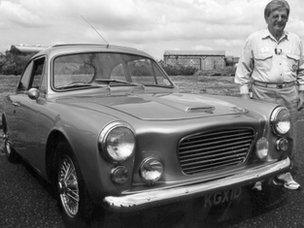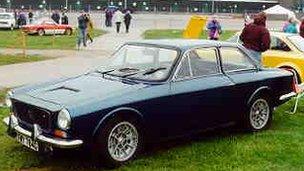The Welsh fibreglass car that took on Jaguar and BMW
- Published

Giles Smith and a GT, the first Gilbern car he created with Bernard Friese
Classic car aficionados descended on the National History Museum at St Fagan's on Sunday to celebrate the short life of Wales' only car company.
The South Wales group of the Gilbern Owners Club brought the annual Gilbern Weekend to their area, as they do every four years.
These cars, manufactured between 1959 and 1974, returned to their spiritual home, just a few miles from Llantwit Fardre, where two eccentric engineers built cars to take on the best British and German sports cars in a garage behind a butcher's shop.
It's a story of Welsh pride, engineering bravery in the face of big business and eventual failure in an economic crisis.
Bryan Mote, member of the Gilbern Owners Club and organiser of the weekend, is one of those 700 or so people worldwide who owns one of these cars.
"Most Gilbern owners love their cars because of the rarity, driveability and Welshness," he said.
"These cars were a wonderful feat for a local butcher and ex-prisoner of war, experimenting with fibre glass."
Giles Smith of Llantwit Fardre and Kent-based ex-prisoner-of-war Bernard Friese met by chance in the late 1950s and decided to build a one-off car in the fibreglass technology that both men admired.
Their first effort was judged, by Welsh racing driver Peter Cottrell, as too good to be a one-off.
Encouraged by this, they started production, to praise from the motoring press. Over 1000 GTs, Genies and Invaders were produced over the next 14 years.
By 1966 Gilbern had begun putting powerful V6 engines in its cars, taking on the might of British makes like Jaguar and Rover, and the German likes of BMW and Mercedes.
It had a celebrity following, with drivers including the Prince of Wales, Sir Anthony Hopkins and Ms Marks, of Marks and Spencer fame.
Gilbern Cars eventually fell victim to the 1974 economic crisis, with the stock market and the three-day week playing more of a part even than the oil crisis.
Increased value
Bryan Mote says that Gilbern cars are only going up in value. "Out of about 1000 cars produced, the club are aware of about 700 still around, with many undergoing restoration or awaiting restoration.
"The value in recent times has increased, with a restorable car from about £2,000 to a concours-standard car as much as £18-20,000."
The fibreglass body of the Welsh car means that they have a survival rate matched only by the likes of Aston Martin and Rolls Royce.
Philip Ivimey of the Gilbern Owners Club, talking to BBC Wales after the funeral of Giles Smith in 2003, said: "The Gilbern was in its time the very best in terms of quality and I think that it is up there with Lotus and TVR."
The Gilbern Weekend took in a range of locations across south Wales, including a two-hour drive through the Vale of Glamorgan.

The Gilbern Genie was produced from 1966 until 1970
That included a visit to Llandow, where the prototype car was tested by the late Peter Cottrell in 1959, and the site of the factory at Llantwit Fadre.
The highlight of the weekend was a static display at St Fagan's, featuring around 50 cars, which were judged in different classes.